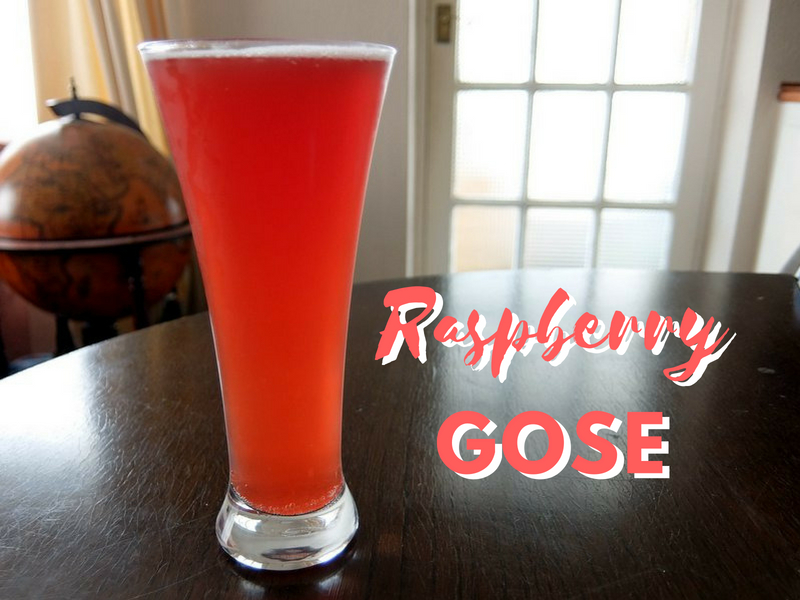Raspberry Gose Recipe – Salty & Tart
When it comes to brewing your own beer you soon come to realise there are no hard and fast rules. You have nobody to please except yourself, this Gose recipe is by no means conventional and may even have most people scoffing at how it is made. The thing is though it is pretty delicious and has a thirst quenching quality that many beers cannot match.
This is not a traditional Gose by any stretch of the imagination but then it any beer you make yourself doesn’t have to have any strict definitions or measures.
Table of Contents
Salt & Sour Gose
If you don’t know a Gose is a pretty unique style of beer, it is both salty and sour.
Gose originated in the Goslar region of Germany where the water used for brewing had a distinct saltiness. Now, all water has some amount of salt in, just in tiny undetectable amounts. The difference with the water used for brewing Gose is that you can taste the salt.
Gose achieved its sour, tartness as it was spontaneously fermented, traditionally the brewers wouldn’t add yeast but allow wild yeast and bacteria to ferment the wort. This practice would have then been refined by using strains of brewers yeast alongside lactic acid bacteria to create a nicely balanced tartness with a fully fermented beer.
Lactobacillus bacteria ferment sugars and at the same time produce lactic acid. It is this acid that adds a distinct tartness to the beer. The other attributes they have are they are comfortable thriving in a salty environment, something which anyone who has made Sauerkraut will know.
Cheats Sour Gose
As homebrewers, we can effectively brew a traditional Gose by adding salt to the wort and purchasing a lactic acid bacteria culture and using this to ferment alongside regular brewing yeast creating a mixed fermentation.
The thing is though lactobacillus takes a while to get working. Taking a couple of months to produce enough lactic acid to give a noticeable tartness to the beer. If you have the time to invest this method this is fine but for a beer with a quick turnaround, we can improvise a little cheat.
Acidulated Malt Sour Beer
When designing this beer I decided I wanted to brew this Gose quickly and have a fair amount of tartness. The quickest way to drop the pH of the beer excluding techniques like kettle souring which take a fair amount of time on the actual brew day is by adding lactic acid. This could be introduced in one or two ways:
- Adding food grade lactic acid
- Adding acidulated malt to the end of the mash
I have used acid malt a lot to adjust the pH of my mash but never in any great amount. The more you add the lower the pH drops. Usually, you would only add 1 – 2% of the grain bill to adjust the pH. If you add something closer to 15 – 20% you are going to end up with a tart beer.
Weyermann produces an acidulated malt that I believe is produced using lactic acid bacteria rather than being treated with lactic acid. This is how brewers under the rules of reinheitsgebot would have adjusted their mash pH without adding any ingredients other than malted barley, hops and yeast.
Weyermann has even alluded to the fact that using their acid malt has a larger portion of your grain bill will produce a subtle tartness so I like this as a way to make this Gose.
Adding Tart Fruit To Layer the Sourness
I didn’t want the sour part of this beer to come across as one dimensional, to get a flavour more akin to using lactic acid bacteria to ferment I decided to add a fairly tart fruit in the form of raspberries to give the beer a little more complexity and flavour.
Adding fruits like raspberries, I find, is best done at the end of primary fermentation. This way the delicate flavour of the raspberries is preserved.
Clean the fruit and pick through as needed, I added the fruit in a fine mesh bag and didn’t bother to sanitise in any way. The pH of the beer is already pretty low and will be resistant to any bacteria that may be on the fruit.
How Much Salt In A Gose
This is a tricky question, I found myself doing a lot of research online and couldn’t come up with a definitive answer. I tried experimenting to see how much a salt in a litre of water would be perceptible, what you have to remember though is salt is a flavour enhancer so no matter how much you add it should enhance the flavour somewhat.
When To Add The Salt
There are two options as to when you should add the salt to this Gose. Either before are after fermentation. I was a little worried that adding salt to the wort prior to adding the yeast would be a little stressful on the yeast considering the low pH but I added the salt at the end of the boil with no problems.
I would say if you want to add more salt than the amount I have added to this recipe that you may want to add it after fermentation is complete.
Recipe Details
| Batch Size | Boil Time | IBU | SRM | Est. OG | Est. FG | ABV |
|---|---|---|---|---|---|---|
| 18.9 L | 60 min | 12.0 IBUs | 6.8 EBC | 1.046 | 1.010 | 4.7 % |
Fermentables
| Name | Amount | % |
|---|---|---|
| Wheat Malt, Ger | 1.904 kg | 47.03 |
| Pilsner (2 Row) Ger | 1.333 kg | 32.92 |
| Acid Malt (added after main mash) | 811.7 g | 20.05 |
Hops
| Name | Amount | Time | Use | Form | Alpha % |
|---|---|---|---|---|---|
| Perle | 9.5 g | 60 min | Boil | Leaf | 11 |
Miscs
| Name | Amount | Time | Use | Type |
|---|---|---|---|---|
| Salt | 20.00 g | 0 min | Boil | Water Agent |
Yeast
| Name | Lab | Attenuation | Temperature |
|---|---|---|---|
| SafAle German Ale (K-97) | DCL/Fermentis | 73% | 15°C - 24°C |
Mash
| Step | Temperature | Time |
|---|---|---|
| Mash In | 65°C | 75 min |
Download
| Download this recipe's BeerXML file |





Uhhh, why didn’t you kettle sour this instead of adding a shitload of acid malt? Adding acid malt is about affective and correct as just dumping in concentrated lactic acid
Give the recipe a try and see what you think!
Sounds great! What about raspberry? How much did you add? Was it ok? Does it needed a little bit more? A little bit less? Thanks.
I added about a kilo to this recipe for 19 litres